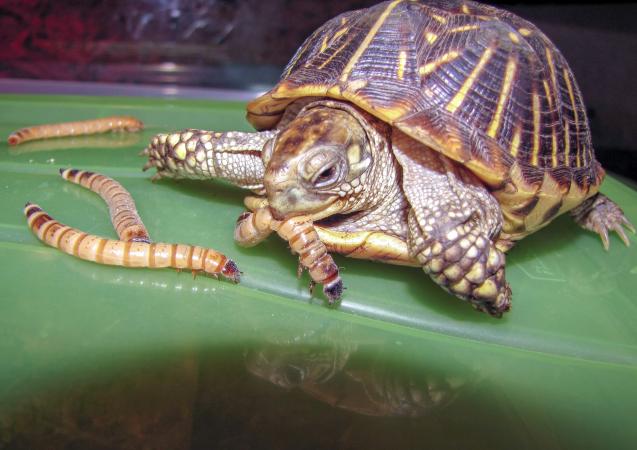Scientific Facts
| Common Name: | Eastern Box Turtle |
| Scientific Name: | Terrapene carolina carolina |
| Life Span: | More than 20 years (captivity) |
| Size: | 4 to 6 inches |
| Habitat: | Pastures, under fallen logs, open grasslands, and moist ground |
| Country of Origin: | United States |
Physical Description

The eastern box turtle is among the subspecies of the common box turtle. This turtle species has a high-domed, hard, and rounded carapace. Those bright yellow and orange markings on its brownish shell makes the eastern box turtle different from other box turtles, coupled with the 4 toes on its hind feet.
With its distinct coloring, this turtle can easily hide with those fallen leaves, damp earth, and other debris on the ground. Predators often struggle in finding this turtle in its natural habitat.
The plastron or underside of the turtle’s shell is hinged and dark brown. The box turtles have bilobed plastron that lets them shut completely their shell. When scared, the box turtles immediately pull their body into the shell and wait until the threat disappears. The shell of an eastern box turtle is unique as it can regenerate. Even the carapace of the badly burned box turtle can regenerate.
Box turtles are known for their hooked upper jaws and slightly webbed feet. Determining their sex is also easy as the male turtles differ from females in many ways. One is the size. Male box turtles are typically bigger and with thicker and shorter tails compared to females. The males also have thick, short, and curved hind claws, but females have straight, long, and thin hind claws. Also, male eastern box turtles have red eyes, while females have brown eyes.
The eastern box turtle walks energetically with its head upright. It can travel for up to 50 meters in a day. Like dogs and cats, this box turtle also has the homing instinct. Therefore, it can always find the right way back to its home as it travels.
On average, the eastern box turtle measures 4 to 6 inches. Sometimes, they reach over 7 inches long. Adult turtles weigh roughly 5 pounds.
Subspecies
Aside from the eastern box turtle, there are other subspecies of box turtles. These include:
Terrapene c.bauri
This box turtle measures around 11 by 8 centimeters with vivid yellow markings on its carapace. Its plastron has lines just like the head. Also, this box turtle has 3 toes on its hind feet.
Terrapene c. triunguis
This one seems the same as the eastern box turtle, but with a narrow shell. This box turtle has an olive or tan-colored carapace with darker seams and a few vague markings. Its plastron is lighter yellowish. Also, this box turtle subspecies has yellow, orange, or red spots on its head and forelimbs. If the turtle is male, its head is completely red.
Terrapene c. major
It is the biggest box turtle measuring 18 x 12 centimeters. It also has a dark brown shell without patterns. Its skin and plastron are dark with 4 toes on its hind feet.
Range

The eastern box turtle commonly exists near the ponds, meadows, fields, and woodlands across the eastern half of the US. Though it is native to the eastern US, it also exists in some other parts of the country.
That’s true because the box turtles are popular pets. When owners don’t want to take care of them anymore, they just set the turtles free into the woods. It may seem helpful to these animals, but it can be so difficult for domestic turtles to endure and survive in a different setting. Therefore, it is best to leave them at local animal shelters or veterinary clinics.
Habitat
The eastern box turtle wants to stay in a deciduous forest area with a moist forest floor. it prefers bottomland forest, unlike the hillsides or ridges. You will also see it in the moist ground, pastures, under fallen logs, and open grasslands. Sometimes, the eastern box turtle takes a bath in the puddles, ponds, and shallow streams. If the weather is hot, this turtle tends to submerge itself in the mud.
This type of box turtle likes warm weather. However, if the environment gets too hot, it will seek some protection from the sun. In case of extreme heat, the eastern box turtle will hide under the logs and leaves. It may also swim in the pond. If the temperature is bearable, then the eastern box turtle will either look for its next meal or basking under the sun.
Sleeping Habits and Hibernation
The eastern box turtle adjusts its activity to maintain the ideal body temperature. In summer, this box turtle is more active early in the morning and even after the rain. In the spring and fall, the eastern box turtle stays active during the day and have fun while exposing itself to the sun.
The eastern box turtles living in the southern region stay active during winter. In the northern areas with colder climates, the animal will look for a comfortable place where it can be insulated known as the hibernaculum. In this period, the eastern box turtle becomes lethargic, entering the hibernation-like status called brumation. This period will start in October or November and end in April when it emerges rain. Sometimes, during warm winter, the turtle wakes up and finds a new resting place.
Behavior
The behavioral pattern for the eastern box turtle is also fascinating. During summer, the adults tend to be more active in the morning and at night, particularly after the rainfalls. Sometimes, they search for a shelter in mammal burrows, mud, rotting leaves or logs to stay safe from the heat.
Although the eastern box turtle is a “land turtle,” it typically enters the puddles and shaded shallow pools in warm weather conditions for several hours to days. It forages in the cold weathers in the day during spring or fall.
Life Span
In the natural habitat, the eastern box turtle lives for more than 100 years. However, in captivity, its lifespan has been recorded for about 40 years.
Predators
Young eastern box turtles are vulnerable to different predators. Adults are less likely to become prey due to their tough, protective shells. All omnivores and carnivores in the woods are predators of this cute-looking box turtle.
Adaptation

The eastern box turtle is crepuscular. Meaning, it is active during dusk and dawn. It hides in burrows to escape from the heat and to sleep comfortably at night. Also, this animal can pull its body parts into the shell to protect itself from the predators. It has a flexible joint on its underside which allows the turtle to fully close its shell for extra protection.
Reproduction

The female eastern box turtle reaches the sexual maturity at the age of 13. The mating season for this animal begins in April and ends in October. The mating process is somewhat time-serving. The male eastern box turtle uses some methods to court a female, such as biting, shoving, or circulating the female. Pre-mounting and copulatory phases occur. The female turtle stores sperm and lays eggs 4 years after mating.
The female turtle will make a nest in June to July. It may travel at a long distance when searching the correct nesting habitat. It can travel for a mile.
Typically, the female eastern box turtle prefers woodland openings, meadows, cultivated gardens, residential lawns, roadsides, and beach dunes as perfect nestling spots.
At times, a female lays eggs in short proximity to the last part of the year. It usually starts nestling in the late afternoon and early at night and go on for up to 5 hours.
Ecosystem Role
The eastern box turtle feasts on various animals, affecting several prey populations. At the same time, it disperses seeds as it eats berries from a variety of plants.
Interactions with Humans
Since box turtles are popular pets, people love them even more for being great seed distributors as they feast on the berries containing seeds. Also, they can eat those insects that can be so harmful to humans. Native Americans had used them for food, ceremonial, medical, hunting, and burial purposes.
On the other hand, eating the eastern box turtle is not a good idea because it eats poisonous mushrooms that don’t hurt the animal. The animal can retain the poison within its body, so the person who eats the turtle will suffer and die. Also, this box turtle can damage some plants like tomato, cucumber, lettuce, strawberry, and cantaloupe.
In some cases, the eastern box turtle destroys the eggs of a ground-nesting bird. It can also become a disease carrier. Some medical reports revealed that the eastern box turtle could carry the western equine encephalitis virus in its blood.
Conservation Status
This box turtle is not considered an endangered species in the national stage within the US, Mexico, or Canada. However, some American states like the New Hampshire, Michigan, Connecticut, and Massachusetts listed the eastern box turtle as one of the turtle species that require special concern. The eastern box turtle is also considered an endangered species in Maine due to road mortality, habitat loss, and collection for the commercial pet trade.
Diet

The behavior of an eastern box turtle when it comes to food changes because of the lighting, temperature, environment, and individual taste. Its metabolism doesn’t push its appetite. Therefore, the animal can diminish its activity level, ingestion, retreat into its hard shell where it stays until the condition becomes favorable.
Likewise, the eastern box turtle is more likely to eat toxic fungi that make its flesh inedible. Anecdotal evidence proves that hatchlings love to eat meat than adults. However, there’s no solid proof in favor of this belief.
Box turtles, especially the eastern box turtle grown in captivity must be fed every other day provided that the animal is not hibernating. It likes to feel warm and nice before it eats, so be sure that the lights in the enclosure or vivarium are on for at least 2 hours before feeding your pet.
The eastern box turtle recognizes food through its scent and appearance. Hence, you must stimulate the sense of sight and taste of your pet to encourage it to eat. You can feed it by providing plant matter or live food/meat products.
This box turtle is an opportunistic omnivore. It can eat a variety of animals and vegetables. Its diet includes earthworms, snails, slugs, grubs, beetles, caterpillars, grasses, fallen fruit, duckweed, mushrooms, carrion, flowers, berries, and even bread. Recent studies also suggest that the eastern box turtle can also eat live birds stuck in the net. When raised in captivity, this animal tends to consume eggs and even hamburger, even if those things are not common in their diet.
For live food/meat products, the eastern box turtle can eat canned dog food and thinly sliced cooked chicken or beef heart. For dog food, the amount should stay within the maximum percentage of 20 percent. You can also feed your pet with live crickets, super worms, mealworms, pink mice, or small snails or slugs.
In feeding an eastern box turtle, every meal should include meat products and plant matter. For plant matter, you can feed the turtle with red fruit, defrosted frozen broccoli, cauliflower, tomatoes, and mixed vegetables. You can also feed it with peaches, apples, apricots, and cantaloupe but in small amounts only.
Be sure your pet’s food is cut small and nice. If the animal is picky eater, you have nothing to worry as it likes variety. Sometimes, you just need to change the menu to encourage your pet to eat.
In the forest, the animal will hibernate and fast during the hot summer. If your pet doesn’t want to eat despite offering it a selection of food, then that could mean your pet is entering the hibernation period. Your pet may not eat for a few weeks. Don’t worry for as long as the animal maintains a healthy weight.
Supplements
With a proper diet, your pet will no longer need supplements for optimum health. Giving them foods fortified with vitamins and minerals will be enough. It is best to provide it with powdered reptile calcium for some time. Just coat its food with this powder. For instance, get some crickets, put it in the bag and sprinkle them with calcium powder and shake them well before giving to your pet.
Housing

The best way to house an eastern box turtle depends on your location. You can keep your pet indoors or even outdoors. A simple outdoor setup should have a consistent temperature that sits between 70 and 85 degrees Fahrenheit in the daytime but not colder than 50 degrees Fahrenheit in the evening. If you want to keep the turtle outdoors even for some hours each day, and the temperature falls under 50 degrees, wait until the temperature goes back to normal. Colder temperatures can harm your pet.
A basic outdoor setup must be at least 2 feet x 4 feet, which is enough for a pair of eastern box turtles. Put the outdoor enclosure in a shaded location. If there’s no area with natural shading, then artificial shading will also work.
Besides, if you prefer to keep your turtles outside your home, then be sure they are protected from the predators. You can use a wire mesh covering or cover the enclosure with a wooden frame.
Keeping an eastern box turtle indoors is also a good idea. Most box turtle keepers prefer an indoor setup for their pets. For one box turtle, you can use a cage that is at least 12 inches wide and 36 inches long. For 2 to 3 turtles, the enclosure must be at least 15 inches tall and 48 inches long. If you use a wooden cage, be sure it is waterproof even when it’s indoors as the animal needs some humidity within the enclosure. For this purpose, you can coat the enclosure with epoxy paint. If not, just buy a pre-sealed wooden enclosure.
For the bedding or substrate, you can use 2-3 inch sheet of peat-based potting soil combined with slim orchid bark. Be sure the potting soil mix doesn’t contain perlite. The best substrate for a box turtle like the eastern box turtle is the one that can hold moisture to boost the enclosure’s humidity, must allow your pet to burrow, and must have a quick-drying surface.
Your best options include orchard bark, fir bark, and pea gravel. Avoid using soggy materials such as the aquarium gravel and silica sand. These materials may wear down the shell of your pet and cause infections.
Shelters
Your eastern box turtle needs a hiding place where it may spend hours for some time. Be sure to add a log or any other hiding space for your pet. The hide box should be large enough so that the turtle can easily get in and out whenever it wants to.
Making a box turtle happy is quite easy as the animal doesn’t require fancy furniture and accessories for its cages. An ordinary hiding place would be enough. Choose something simple such as the wooden half-log and cork hiding place suitable for an eastern box turtle. Without a hiding spot, your pet’s life can be stressful and boring.
Light and Heat
Proper heating is the most crucial factor in the survival of your pet. Most of the issues faced by people who keep an eastern box turtle for the first time can be fixed with proper heating. The following methods may help:
- Using a sub-tank reptile heating system or placing a hot rock heater within the substrate.
- Using overhead incandescent lights or spotlights on top of the enclosure’s basking section.
This method must be used together with the heated floor. The temperature underneath the bulb needs to be between 84 and 88 degrees Fahrenheit. Likewise, it must be connected to the timer, which gives 12 to 14 hours of light every day.
The light should have UVA and UVB as it should be around 18 inches apart from the turtle. Lastly, keep in mind that there should be no plexiglass, glass, and plastics should be under the light as these materials can filter out the useful rays of the sun.
Humidity
Keeping the humidity level between 60 and 80 percent is important for the survival of the captive box turtles. Daily misting can help maintain humidity at the ideal level.
Find out if your pet’s enclosure is humid enough. One sign of insufficient humidity is excessive burrowing. If that is the case, your pet will dig out and find moisture. If the animal fails, it will be stressed or sick.
Water
The eastern box turtle also needs access to fresh and clean water for drinking and soaking in. Despite giving your pet weekly baths, your pet would be happier if you give it a “water pond.” Therefore, don’t forget to add a water bowl to the enclosure. It must be large for the animal. Also, the water bowl should be strong and can handle your pet’s weight as it gets into the bowl.
However, it should be shallow enough that your turtle’s head is on top of the water at all times. The eastern box turtle is a good swimmer, but it may still get drowned. You can purchase a decorative bowl from the pet store. However, this will be for your benefit since your pet doesn’t care what the water dish looks like.
Most turtle owners include flowerpot dishes and narrow ceramic bowls inside their pet’s habitats. Whatever kind you buy for your pet, its cleanliness is still more important. You need to clean your pet’s water bowl as often as possible to eliminate the poops in the water.
If you’re keeping a box turtle inside an open-air habitat, consider making a real miniature pond within the enclosure. Pond liners are widely available in different pet supply shops today. Make the pond beautiful by adding fake or real plants, stones, and real fish – making the pond a good source of fresh food for your pet.
Be sure also that the pond is shallow, but the turtle is not struggling to get in and out of it. The pond must be in the shaded area to keep the water cool. Replace the water in the bowl every day. Do it either by using a filter pump or a water vacuum.
Handling

Compared to other types of turtles, the box turtles do not find being handled a happy and satisfying experience. Your pet is not craving for the warmth and touch of your caring hands. Instead, the eastern box turtle is at its best when you don’t touch it often.
Box turtles of all forms can be wonderful display animals but may hesitate to eat food if it’s on your hands. However, with patience, this animal finally learns to take food from its owner’s hands.
Like other reptiles, the box turtles are common carriers of salmonella. Therefore, you must never let it roam inside your home with freedom. Don’t forget to wash your hands after handling your pet to keep yourself safe from salmonella. Everyone is at risk for diseases caused by salmonella, but kids, seniors, and immune-compromised persons are more vulnerable to those health problems. So, keep your hands, the environment, and whatever is in your pet’s cage, such as the hiding box and water bowl.
Common Health Problems in Eastern Box Turtles
The eastern box turtle and other box turtles are prone to different health problems involving parasites and other health conditions. Outlined below are the most common health problems seen in these turtles.
Dehydration
It is among the most typical issues you may encounter in keeping a box turtle. In most cases, the turtles sold at the pet stores are mildly dehydrated. Their skin is not elastic and will never retract deeply within the shell. If your pet is dehydrated, soak it in a bowl of lukewarm water and let it stay there for hours. In the next few days, allow the turtle to soak in the water for reduced periods, limiting the time to just 15 or 20 minutes twice or thrice every day. soaking amazingly helps in rehydrating a box turtle. The animal may gain more weight after soaking it for the first time.
Parasites
The box turtles of all kinds are prone to parasites, specifically the nematode parasites. The parasitic flies are also a common problem associated with these turtles. Remember, even when you cannot see parasites in the poop of your pet, it does not mean they are not there. These microorganisms are so small that they are not visible to the naked eye.
Parasitic flies lay eggs on the shell of your box turtle and at the wound sites. They can breed even in the small scratches. Eventually, these eggs will hatch, and the larvae would feed on the animal’s tissue. Known as myiasis, the problem takes place in just 2 forms.
In one form, the problem happens when more parasitic flies lay their eggs at the wound site, and when the eggs hatch, the maggots will feed on the surface tissue. In this situation, you have to wash or pluck off the maggots then clean your pet’s wound carefully using Betadine or hydrogen peroxide. Also, apply an antibacterial ointment. Repeat the entire procedure every day.
In the other form, myiasis is more serious and is due to botflies. Botflies don’t require a wound site for laying the eggs. Instead, these parasites create one with a tiny bite. When the eggs hatch, the larvae will dig under the skin of your pet. The burrows they made are like lumpy masses upon closer inspection. When botflies affect your pet, you will need to take the turtle to a veterinarian or drain the pockets on your own.
Even when start treating your eastern box turtle at home, still you should seek help from a certified exotics veterinarian. Professional help is highly necessary with any larval or parasitic infections.
For turtles kept outdoors (even part-time), your pet may still get infected by ticks. If you see a tick or two on your box turtle, you must remove them as soon as possible. In getting rid of ticks, pull on their heads tightly until they release. Be sure you pull them straight up. If you don’t do this, you may end up leaving their mouth portion behind.
Availability – Where to Get One?
Since they are popular, rest assured box turtles are easy to buy in whatever way go. The box turtles like eastern box turtle are widely available at the local stores, professional breeders, and even online pet stores
How to Care for an Eastern Box Turtle?
As great reptile pets, taking care of a box turtle is no doubt a fun experience. Though the eastern box turtle is not as friendly as the other types of turtles, it remains a good choice of pet for some reasons. An eastern box turtle is so easy to manage.
To keep your pet happy, you must keep in mind these tips:
- Choose the best enclosure for your eastern box turtle. If you choose to keep the animal indoors, then provide it with a big indoor enclosure. Don’t use aquariums as it will be too small for this turtle. Also, provide your pet with accessories like a hiding box, plants, bark, and anything else that makes the enclosure look like the turtle’s natural habitat.
- Think about temperature and humidity. Follow the guidelines provided above for these two. Again, lower humidity levels and colder temperatures can stress an eastern box turtle and make it sick.
- Give it water. You may not see your pet doing this, but a turtle always needs clean water. Whenever you come closer to the enclosure, check everything inside, especially the water bowl. Replace the water daily.
- Avoid touching your pet a lot. Most reptiles are okay with regular handling, but the case is different for some. Unlike other turtle species, regular handling is not suitable for the eastern box turtle. It causes stress to the animal. At least, you can try teaching your pet to take the food from your hand.
- Lastly, feed your pet well. Be sure its daily diet consists of both meat products and vegetables. Don’t offer it the same food or meal every day. Do some mix and match. Your pet wants a variety when it comes to food. Choose the best food for your eastern box turtle to keep it strong, active, healthy, and happy.
Fun Facts about the Eastern Box Turtle
- Predators often chase the young eastern box turtles instead of the adults. This is because young turtles don’t have tough protection yet. Their shells are not as strong as the shells of adults, so predators can easily kill and eat them. Their shells are getting harder at the age of 8.
- Although females lay their eggs hundreds of eggs in their lifetime, only 2 to 3 of them survive and reach adulthood.
- The shells of eastern box turtles can regenerate no matter how injured or damaged they are.
FAQ
How can I tell that my eastern box turtle is sick?
You can tell that your eastern box turtle is sick by watching out for the early signs of diseases. Usually, it starts with a change in the turtle’s eating pattern and activity.
Is the eastern box turtle a good pet?
Though it doesn’t like frequent handling, the eastern box turtle is so manageable, making it a good reptile pet. This box turtle is a colorful reptile and a good choice for a display pet.
Does an eastern box turtle get lonely?
Like other box turtles, the eastern box turtle is a solitary animal and never an attention-seeker. It is not cuddly as it feels better if you leave it alone for most of the time.
How often should I feed my eastern box turtle?
Young turtles should eat daily, but older turtles are okay with just one meal a day or even the other day. Feed your pet based on its appetite.
Will my eastern box turtle die if I move it?
The eastern box turtle struggles to settle down in its new location if you moved it. Your pet will walk pointlessly as it tries to find its old home until it dies.
Is eastern box turtle dangerous?
While eastern box turtle can be a good pet, taking care of it becomes a dangerous experience due to poor husbandry and handling. This turtle is an asymptomatic carrier of Salmonella, so always wash your hand after handling the animal and its enclosure.
Does eastern box turtle bite?
The eastern box turtle is not friendly but not aggressive, too. It is less likely to bite.
Can an eastern box turtle recognize its owner?
You may not notice, but every turtle has the amazing ability to recognize its owner. This is true even for the eastern box turtle.
How long does the eastern box turtle live?
Box turtles are known to be capable of surviving for up to 100 years. However, the eastern box turtle is most likely to live for more than 20 years, depending on how you handle and manage the animal.



